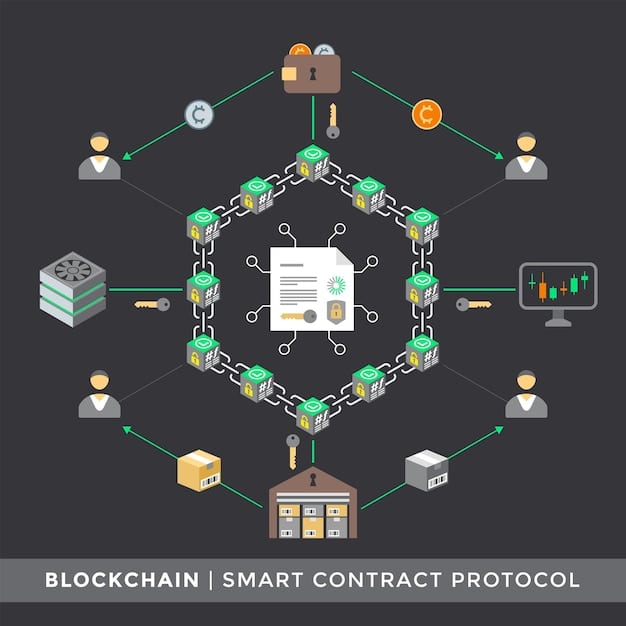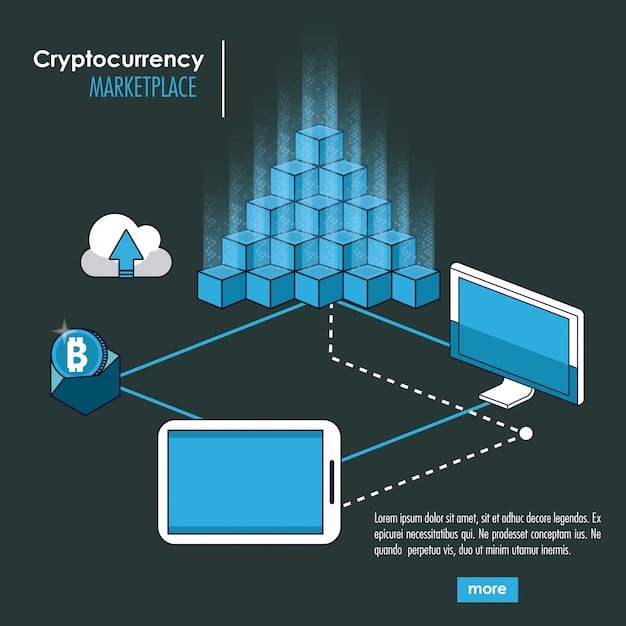Enterprise Blockchain Platforms: A 2025 Comparison for US Businesses

Enterprise Blockchain Platforms: A Detailed Comparison for US Businesses in 2025 examines the leading platforms, assessing their features, scalability, security, and suitability for diverse enterprise applications in the evolving blockchain landscape.
The rise of blockchain technology has created a need for robust **Enterprise Blockchain Platforms: A Detailed Comparison for US Businesses in 2025** to guide decision-making. As US businesses look to leverage blockchain to streamline operations, enhance security, and foster innovation, understanding the nuances of each platform becomes critical. This article offers an in-depth look at the premier enterprise blockchain solutions poised to shape the landscape in 2025, providing a clear **Enterprise Blockchain Platforms: A Detailed Comparison for US Businesses in 2025**.
Why Enterprises Are Turning to Blockchain Platforms
Enterprises are increasingly adopting blockchain platforms to solve various challenges, from supply chain management to secure data sharing. The technology’s decentralized and immutable nature promises increased transparency, enhanced security, and improved efficiency.
Benefits of Blockchain for Enterprises
Blockchain offers several key advantages for businesses:
- Enhanced Security: Cryptographic techniques ensure data integrity and prevent unauthorized access.
- Increased Transparency: All transactions are recorded on a shared ledger, promoting trust and accountability.
- Improved Efficiency: Automation through smart contracts streamlines processes and reduces costs.
- Supply Chain Optimization: Track and trace goods from origin to consumer, reducing fraud and improving logistics.
These benefits are driving the demand for Enterprise Blockchain Platforms: A Detailed Comparison for US Businesses in 2025, as companies seek to implement blockchain solutions tailored to their specific needs.

Key Considerations for Choosing a Platform
Selecting the right blockchain platform requires careful consideration of several factors:
- Scalability: The platform should be able to handle increasing transaction volumes.
- Security: Robust security measures are essential to protect sensitive data.
- Interoperability: The platform should be able to integrate with existing systems and other blockchains.
- Cost: Consider the total cost of ownership, including development, deployment, and maintenance.
For US businesses, understanding the regulatory landscape and compliance requirements is also critical when evaluating Enterprise Blockchain Platforms: A Detailed Comparison for US Businesses in 2025.
In conclusion, enterprises are leveraging blockchain for enhanced security, transparency, and efficiency. Choosing the right platform requires careful consideration of scalability, security, interoperability, and cost.
A Detailed Comparison of Leading Enterprise Blockchain Platforms for 2025
In 2025, several enterprise blockchain platforms will be at the forefront, each offering unique features and capabilities. This comparison will help US businesses navigate the options available.
Hyperledger Fabric
Hyperledger Fabric is a modular blockchain framework hosted by the Linux Foundation, designed for building enterprise-grade solutions.
Hyperledger Fabric suits use cases needing permissioned networks and strong identity management. Its pluggable architecture supports different consensus mechanisms, cryptography, and membership services.
- Permissioned Network: Controls who can participate and transact on the network.
- Modular Architecture: Allows customization and flexibility to meet specific business requirements.
- Smart Contracts: Supports chaincode written in Go, Java, and Node.js.
- Strong Identity Management: Provides robust mechanisms for user authentication and authorization.
Its flexibility and scalability make Hyperledger Fabric one of the top choices in the **Enterprise Blockchain Platforms: A Detailed Comparison for US Businesses in 2025**.
R3 Corda
R3 Corda is a blockchain platform designed for managing complex financial agreements and transactions, focusing on privacy and regulatory compliance.
Corda is tailored for financial institutions and other regulated industries, providing tools for building secure and compliant distributed applications.
- Privacy-Focused: Transactions are shared only with relevant parties, ensuring data confidentiality.
- Regulatory Compliance: Designed to meet the requirements of financial regulators.
- Smart Contracts: Supports contracts written in Java and Kotlin.
- Interoperability: Integrates with existing financial systems and other Corda networks.
For US businesses in the financial sector, R3 Corda stands out as a strong contender in the **Enterprise Blockchain Platforms: A Detailed Comparison for US Businesses in 2025.**
In summary, Hyperledger Fabric offers modularity and permissioned access, while R3 Corda focuses on privacy and regulatory compliance, making them suitable for different enterprise needs.
Scalability and Performance Considerations
Scalability and performance are critical factors for enterprise blockchain platforms, especially as transaction volumes increase.
Businesses must choose platforms that can handle their current and future needs without compromising speed or reliability.
Consensus Mechanisms
The consensus mechanism used by a blockchain platform significantly impacts its scalability and performance.
Different consensus algorithms offer varying trade-offs between speed, security, and decentralization.
- Proof of Work (PoW): Used by Bitcoin, PoW is secure but slow and energy-intensive.
- Proof of Stake (PoS): Offers faster transaction speeds and lower energy consumption compared to PoW.
- Practical Byzantine Fault Tolerance (pBFT): A consensus algorithm designed for permissioned networks, providing high throughput and fault tolerance.
- Delegated Proof of Stake (DPoS): Allows stakeholders to delegate their voting power to representatives, improving scalability.
Choosing a consensus mechanism that aligns with the business’s specific requirements is essential when considering **Enterprise Blockchain Platforms: A Detailed Comparison for US Businesses in 2025**.
Transaction Throughput
Transaction throughput refers to the number of transactions a blockchain platform can process per second (TPS).
High transaction throughput is crucial for applications requiring real-time data processing and high volumes of transactions.
Platforms like Hyperledger Fabric and R3 Corda are designed to handle thousands of transactions per second, making them suitable for enterprise use cases.

Layer-2 Solutions
Layer-2 solutions, such as state channels and sidechains, can improve the scalability of blockchain platforms by offloading transactions from the main chain.
These solutions enable faster and cheaper transactions while maintaining the security and integrity of the underlying blockchain.
Many Enterprise Blockchain Platforms: A Detailed Comparison for US Businesses in 2025 incorporate Layer-2 solutions to enhance their scalability and performance.
In conclusion, scalability and performance depend on the consensus mechanism, transaction throughput, and the use of Layer-2 solutions. Businesses must choose platforms that can effectively handle their transaction volumes.
Security and Compliance Considerations
Security and compliance are paramount for enterprise blockchain platforms, especially when dealing with sensitive data and regulatory requirements.
US businesses must ensure that their chosen platform meets the highest security standards and complies with relevant regulations.
Data Encryption
Data encryption is a fundamental security measure that protects sensitive information from unauthorized access.
Blockchain platforms use various encryption techniques to secure data both in transit and at rest.
- Symmetric Encryption: Uses the same key for encryption and decryption, offering fast performance.
- Asymmetric Encryption: Uses a pair of keys (public and private) for encryption and decryption, providing enhanced security.
- Homomorphic Encryption: Allows computations to be performed on encrypted data without decrypting it.
Choosing a platform with robust data encryption capabilities is crucial when evaluating **Enterprise Blockchain Platforms: A Detailed Comparison for US Businesses in 2025**.
Access Controls
Access controls define who can access and modify data on the blockchain network.
Role-based access control (RBAC) is a common approach that assigns permissions to users based on their roles within the organization.
Platforms like Hyperledger Fabric offer granular access controls, allowing businesses to enforce strict data governance policies.
Regulatory Compliance
Regulatory compliance is a critical consideration for US businesses using blockchain platforms.
Depending on the industry and use case, businesses may need to comply with regulations such as GDPR, HIPAA, and PCI DSS.
Choosing a platform that supports compliance efforts and provides the necessary tools and documentation is essential when considering **Enterprise Blockchain Platforms: A Detailed Comparison for US Businesses in 2025**.
In summary, security and compliance require robust data encryption, access controls, and adherence to regulatory standards. US businesses must prioritize these considerations when selecting an enterprise blockchain platform.
The Future of Enterprise Blockchain Platforms in 2025
The landscape of enterprise blockchain platforms will continue to evolve, driven by technological advancements and changing business needs.
In 2025, we can expect to see increased adoption of blockchain technology across various industries, along with greater interoperability and standardization.
Interoperability
Interoperability is the ability of different blockchain platforms to communicate and exchange data with each other.
As more businesses adopt blockchain technology, the need for interoperable platforms will become increasingly important.
Efforts are underway to develop standards and protocols that enable seamless communication between different Enterprise Blockchain Platforms: A Detailed Comparison for US Businesses in 2025.
Standardization
Standardization is the process of establishing common standards and protocols for blockchain technology.
Standardization will promote interoperability, reduce fragmentation, and accelerate the adoption of blockchain technology.
Organizations like the IEEE and ISO are working on developing standards for blockchain terminology, security, and data formats.
Emerging Trends
Several emerging trends will shape the future of enterprise blockchain platforms in 2025:
- Blockchain-as-a-Service (BaaS): Cloud-based services that provide pre-built blockchain infrastructure and tools.
- Decentralized Finance (DeFi): Financial applications built on blockchain technology, offering transparency and accessibility.
- Non-Fungible Tokens (NFTs): Unique digital assets that represent ownership of items such as art, collectibles, and real estate.
| Key Point | Brief Description |
|---|---|
| 🔒 Security | Blockchain enhances data security through encryption. |
| ⚙️ Scalability | Choose platforms that handle increasing transaction volumes. |
| 🤝 Interoperability | Ensure the platform integrates with existing systems. |
| ⚖️ Compliance | Meet regulatory requirements like GDPR and HIPAA. |
Frequently Asked Questions
Enterprise Blockchain Platforms: A Detailed Comparison for US Businesses in 2025 offer enhanced security, increased transparency, and improved efficiency for various business processes, including supply chain management and data sharing.
Consider factors such as scalability, security, interoperability, cost, and regulatory compliance when selecting a blockchain platform. Align these factors with your specific business requirements.
Hyperledger Fabric is a modular blockchain framework designed for building enterprise-grade solutions. Its permissioned network, modular architecture, and strong identity management are key benefits.
Essential security measures include robust data encryption, strict access controls, and adherence to regulatory standards. These measures protect sensitive data from unauthorized access.
Emerging trends include Blockchain-as-a-Service (BaaS), Decentralized Finance (DeFi), and Non-Fungible Tokens (NFTs). These trends will shape the future of blockchain technology.
Conclusion
As US businesses navigate the complex world of blockchain technology, understanding the nuances of Enterprise Blockchain Platforms: A Detailed Comparison for US Businesses in 2025 is paramount. By carefully evaluating factors such as scalability, security, interoperability, and regulatory compliance, companies can unlock the transformative potential of blockchain.





